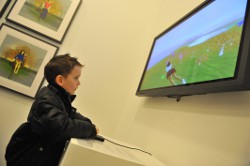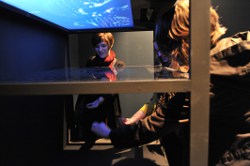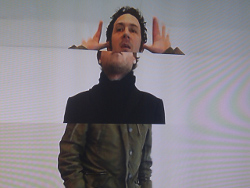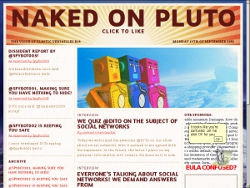Robots and Avatars @ FACT
a review by Steve Boxer
Documentation:
Gallery | Video | Vodcasts | Reports | Live Reporting
Robots and Avatars’ first exhibition is now up and running at the FACT gallery in Liverpool. And this is what it’s like.
Robots and Avatars is a programme of reflexion, debates and learning experience exploring future world of work and play, which began in 2009. It was originally conceived and produced by East London based design collective body>data>space who led the project through research and development into an EU Culture project involving 5 other UK and European partners.
'At the centre of the group has always been the idea that digital technologies are great, but what’s the point of it all if it’s not going to relate to the living emotional body, and how we need them to work for us and complement us, rather than us having to learn to work with them?’ Ghislaine Boddington, body>data>space creative director
If you’ve been wanting to experience for yourself what Robots and Avatars is all about, you can now. All you have to do is get to Liverpool, and seek out the Foundation for Arts and Creative Technologies (FACT) , in a conveniently central location. The first Robots and Avatars exhibition is on show there until 27 May, and it contains a wealth of interactive installations that are both massively great fun to play with and which provoke all sorts of thoughts and explore many issues concerning robots and avatars in the future world of work and play. We went to the launch of Robots and Avatars at FACT on 16 March, and thought we’d share with you a detailed description of what it is like.





 Head back towards FACT’s stairs, and you will discover a final room containing Robots and Avatars exhibits – this time existing in the virtual space, and viewed via computers. These are typically provocative, impressive to behold and fun to discover.
They include UKI, by Shu Lea Chang, a shadowy figure purported to be a hacker. It’s a provocative cyberpunk film forming a sequel to her first work, I.K.U, with a videogame element added to the visuals and sound. Matthew Cherubini’s rep.licants.org explores the notion of real and computer-controlled identities in social networking – it lets you install AI bots on your Facebook and Twitter accounts, which simulate your online activity and – who knows? – may lead to a sharp increase in your friends and followers. Naked On Pluto, by Aymeric Mansoux, Dave Griffiths and Marloes de Valk, is a playful work that sets 57 AI bots to work on your personal online data, parodying the data mining that increasingly takes place on behalf of the giant social networking companies. And The Electronic Man, by Salvatore Iaconesci and Oriana Persico, is a more sober installation. Influenced by 1960s icon Marshall McLuhan, it’s a crowd-sourced project which lets visitors scan QR codes around the world, enter their emotions and thereby build up an ever-changing emotional map of the world.
That, then, is what you will find if you head to FACT in search of Robots and Avatars. We hope that, as well as keeping you amused and entertained for the best part of a day – no matter your age or inclinations -- it will get you thinking about a future world in which, both at work and at play, we coexist with robots and avatars happily and productively. And please bear in mind that this is just the beginning: Robots and Avatars will feature plenty more installations, performances, workshops and events, so keep watching this space.
Steve Boxer
The Robots and Avatars Exhibition presents at FACT, Liverpool (UK) from 16 March to 27 May 2012, and will tour onwards to AltArt, Cluj-Napoca (Romania) and KIBLA (Slovenia) in 2012.
Head back towards FACT’s stairs, and you will discover a final room containing Robots and Avatars exhibits – this time existing in the virtual space, and viewed via computers. These are typically provocative, impressive to behold and fun to discover.
They include UKI, by Shu Lea Chang, a shadowy figure purported to be a hacker. It’s a provocative cyberpunk film forming a sequel to her first work, I.K.U, with a videogame element added to the visuals and sound. Matthew Cherubini’s rep.licants.org explores the notion of real and computer-controlled identities in social networking – it lets you install AI bots on your Facebook and Twitter accounts, which simulate your online activity and – who knows? – may lead to a sharp increase in your friends and followers. Naked On Pluto, by Aymeric Mansoux, Dave Griffiths and Marloes de Valk, is a playful work that sets 57 AI bots to work on your personal online data, parodying the data mining that increasingly takes place on behalf of the giant social networking companies. And The Electronic Man, by Salvatore Iaconesci and Oriana Persico, is a more sober installation. Influenced by 1960s icon Marshall McLuhan, it’s a crowd-sourced project which lets visitors scan QR codes around the world, enter their emotions and thereby build up an ever-changing emotional map of the world.
That, then, is what you will find if you head to FACT in search of Robots and Avatars. We hope that, as well as keeping you amused and entertained for the best part of a day – no matter your age or inclinations -- it will get you thinking about a future world in which, both at work and at play, we coexist with robots and avatars happily and productively. And please bear in mind that this is just the beginning: Robots and Avatars will feature plenty more installations, performances, workshops and events, so keep watching this space.
Steve Boxer
The Robots and Avatars Exhibition presents at FACT, Liverpool (UK) from 16 March to 27 May 2012, and will tour onwards to AltArt, Cluj-Napoca (Romania) and KIBLA (Slovenia) in 2012.
Martin Bricelj: RoboVox
Just about the first thing you see when you renter FACT is what appears to be a typically anthropomorphic robot standing on a plinth. It is, in fact, RoboVox, created by Slovenian artist Martin Bricelj. Although RoboVox doesn’t move, it is still interactive. Beneath him, on the plinth, you will find a mobile phone number. Send a text to that number and, after a very short delay, RoboVox will speak whatever you texted in. RoboVox is a very simple installation, but is also great fun to play with and, Bricelj explains, explores the concept of robot as slave. He keenly points out that “robot” is the first word from the Slavic languages to become recognisable around the world, and its original meaning was “slave”.Visions of Our Communal Dreams, 2012 / Photographer: Brian Slater
Michael Takeo Magruder: Visions Of Our Communal Dreams
To the right-hand side of the FACT foyer, you will notice what looks like an alcove, in which some curious prints – created with all the trappings of fine art, but featuring avatars that look as though they were created for a videogame, in a Japanese landscape art setting. At the end of the alcove is a screen, showing a figure in a computer-generated forest, together with a keypad that allows you to navigate that avatar. This is the first outcrop you will encounter of Michael Takeo Magruder’s installation Visions Of Our Communal Dreams, a work that wraps itself around the whole of FACT’s space, both downstairs and upstairs, making a number of appearances in unexpected places, in subtly altered forms. Visions Of Our Communal Dreams is a large and ambitious installation that exists in both the virtual and real spaces, and will evolve and mutate during its time at FACT. At its heart is a beautiful virtual island created by Magruder and his team members Drew Baker, Erik Fleming and David Steele, using the open source 3D application server OpenSimulator. The fine art-style prints in the FACT foyer show avatars created by students at Weatherhead Media Academy, where Magruder conducted a workshop. Move around FACT, and you will discover other portals into the Visions Of Our Communal Dreams world, which Magruder calls a “metaverse”. One resembles a wall at the end of the corridor; look closely, and you will notice that it introduces a ghostly image of yourself walking towards it into the virtual world. Another view, by FACT’s cafe, resembles a picture window onto the virtual world. In the upstairs gallery, it is presented as a painting. Soon Magruder and his team will release a toolkit allowing members of the public to create avatars and enter the space, providing the ability for them not only to interact with each other but also with people passing through the portals at FACT. So Visions Of Our communal Dreams will become more populated as time progresses – and you will notice things like computer-controlled birds and butterflies. You may even, for example, be able to plant trees and watch them grow. Conceptually, Visions Of Our Communal Dreams is pretty complex, existing as it does in both the virtual and real realms, but it offers a glimpse into and commentary on the future world of work, which will increasing take place in virtual spaces, and explores how we will choose to represent ourselves via avatars in such real/virtual worlds.ADA - Poland/Germany 2010
Karina Smigla-Bobinski: ADA
Enter one of the ground-floor galleries at FACT and you will be met by a sight which, at first glance, seems to bear little relationship to either robots or avatars, but which is, without a doubt, impressive and hugely beguiling. This is ADA, an installation by Polish-born, Munich-based artist Karina Smigla-Bobinski. ADA is pretty simple to describe: a giant transparent ball, filled with a mixture of helium and air, and studded with charcoal sticks. The gallery itself has been painted white and thereby turned into a giant canvas. And it’s ADA herself which fills in that canvas. When visitors move her around, the charcoal creates marks on the walls and ceilings which leave a trace of their actions and will eventually form an intricate black web. Smigla-Bobinski explains that ADA is essentially an analogue robot: she is a drawing machine, operated by all those who manipulate her. She also has a biotechnological appearance, resembling some sort of virus or microbe. Smigla-Bobinski also named her in honour of Ada Lovelace, whose work with Charles Babbage earned her the title of the world’s first computer programmer. But above all, she is great fun to interact with.Compass - Belgium 2005 / Photographer: Brian Slater
Lawrence Malstaf: Compass
In the next-door gallery to ADA, you will find a bizarre and intriguing installation called Compass. The gallery is darkened, with virtual “walls” created using projected light. And in one corner sits a somewhat sinister-looking object, made of metal, ring-shaped and fitted with straps. That object is Compass, and is designed to be worn by one person while others spectate. An assistant helps you put Compass on: it fits over your hips, held up by straps and an inflatable cushion. When you switch it on, using built-in weights, it guides you around the gallery on a predetermined path, between the virtual walls, and sensing and avoiding spectators. This fascinating work, according to Malstaf, explores issues of trusting in robots, as well as issues of surrendering to machines or opting to retain control over them.Upstairs gallery exhibits
Head upstairs at FACT and you will find even more Robots and Avatars-themed exhibits to stimulate your thought processes and provide all manner of fun interactions. The first thing you see as you enter the main upstairs gallery is the only non-interactive piece at Robots and Avatars: a non-verbal documentary created by Martin Hans Schmitt called Robot World. This depicts the evolution of robots and provides a fascinating bit of context. And all around you are more installations – including further outcrops of Michael Takeo Magruder’s Visions Of Our Communal Dreams..Base 8 - Slovenia / Spain / US 2011 / Photographer: Brian Slater
Chris Sugrue: Base 8
The first installation you encounter is Chris Sugrue’s Base 8, a magical effort which nonetheless makes use of an ancient visual trick called Pepper’s Ghost, popular in theatres in the early 20th century. Base 8 takes the form of a dark, open box with a screen above it, into which you’re invited to place your hand. Once Base 8 detects your hand, it forms what looks like a holographic hand around it, which mirrors any movement you make with your corporeal hand. Move your hand and you will find that virtual particles in the installation are attracted to it. Base 8 isn’t just beautiful to behold: it generates some strange feelings which will have you ruminating on the nature of virtual body extensions, as you learn to control your holographic hand, without being able to feel anything through it.MeYouandUs - United Kingdom 2011
Alastair Eilbeck and James Bailey: MeYouandUs
Move into the main upstairs gallery space and you will be confronted by MeYouandUs, an installation in several parts that undoubtedly dominates the space. One of the first things you notice is a spotlight in the middle of the floor: step into this and whatever you do in it will be filmed for the installation, and chopped into a loop. Facing the spotlight is a composite, looped video collage, split into horizontal layers. Those who are filmed in the spotlight will contribute to one (random) part of that. To the right, you will see a giant projection on the wall which, at first sight resembles an overhead traffic-camera view, and which takes in all visitors to the room. Look at it more closely and you will notice that it, too, is looped: creating a striking, speeded-up crowd movement effect. You swiftly learn that you can use the looping effect to your advantage – YouMeandUs effectively turns you into a video avatar, which you can control remotely by taking advantage of the constant sampling period. The different levels of immediacy which govern the three instances of YouMeandUs lead to consideration of how our representations of ourselves shifts and changes, and how we might present different personas in different situations.Online room
Naked on Pluto - France/Netherlands
